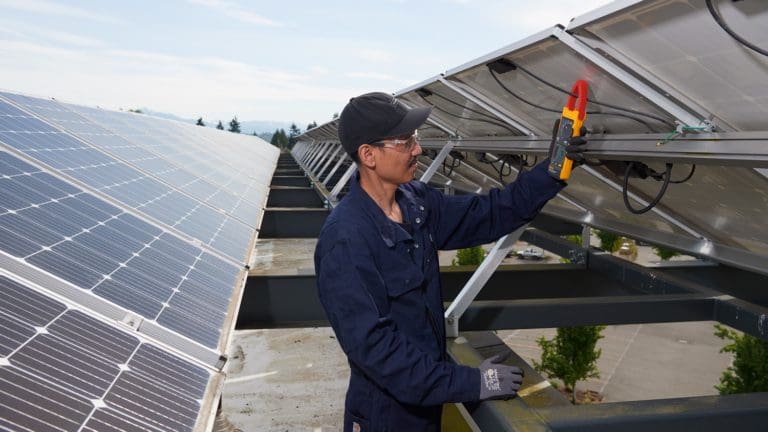
Renewable energy is one of the fastest growing markets in the world – in the UK, solar installations have doubled within the last year and are expected to double again by 2030.
Such rapid expansion is accelerating the search for ways to reduce risks associated with commissioning and installing photovoltaic (PV) systems.
In PV applications current is ‘wild’ and not limited by electronics, therefore choosing the correct solar testing equipment is vital if workers – and the PV system itself – are to be protected against a range of potential electrical hazards.
Electrocution
The Fluke 393 FC is one product that helps to protect against the three main electrical hazards – shock or electrocution from energised conductors, arc faults that spark fires and arc flash that leads to explosions.
Control measures and best practices that can mitigate these risks are different when working with PV to working with any other kind of energy generating resource. That’s why it’s important that multimeters, test leads and fuses are rated for the application being worked on.
Shock or electrocution from energised conductors can happen when current takes an unintended path through a human body, with lethal results from as little as 50 milliamps (mA) hitting the heart.
Electrical shocks are typically caused by a faulty insulation of cables and wiring, damaged insulation of safety covers or improper grounding. The main places such conditions exist in a PV system are the combiner box, the equipment grounding conductor, the PV source and output circuit conductors.
Arc faults and arc flash
Electrical arc faults that spark fires are high power discharges of electricity between two or more conductors, with the discharge causing heat that can lead to the deterioration or even to burning of wiring insulation. PV systems are particularly vulnerable to arc faults caused by disruption in conductor continuity or by unexpected current between two conductors, often the result of a ground fault.
Arc flash is a phenomenon of large-scale PV arrays that have medium-to-high voltage levels. Only since large-scale solar energy systems gave been created has arc flash become a DC issue, which is why arc flash hazard risk analysis must now be carried out on DC systems over 120 V. The issue is particularly prevalent when fault-checking in energised combiner boxes, where PV source circuits are used in parallel to increase current, or when carrying out checks on medium-to-high voltage switchgear and transformers.
An arc flash happens when there’s a significant level of energy available to an arc fault in DC and AC conductors. The flash emits hot gases and radiant energy that can be around 19,500° C (or four times the temperature of the surface of the sun).
The most at risk set-ups are residential inverters with input voltage up to 500 V and large-scale inverters with up to 1500 V. It’s essential to use a meter that’s rated for the relevant measurement category or CAT rating as well as the application’s voltage level. This is so the unit can cope with average voltage levels and high voltage spikes and transients that are capable of producing shocks or causing an arc flash.
Switching to 1500 V
Most major manufacturers of inverters and solar modules are shifting from 1000 V systems to 1500 V for greater efficiency. For solar installations, overvoltage category CAT III 1500 V systems are being more widely used and CAT III and CAT IV equipment is essential for PV systems at high altitudes. The Fluke 393 FC True-RMS Solar Clamp Meter matches the insulation demands of such CAT III environments.
The meter is designed specifically for use by PV installation technicians and maintenance specialists who work in high voltage DC environments. The clamp can measure up to 1500 V DC, 1000 V AC, DC power and current up to 999.9 A DC or AC through the thin jaw which is ideal for the kind of cramped spaces found in combiner boxes or inverters.
Hans-Dieter Schuessele, application and technology expert EMEA, Fluke said: “Safety is essential when commissioning and installing PV systems. The future of power needs tools that are able to keep you safe in harsh environments – risk is not an option and you literally have to trust your meter with your life.
“It’s very important that there’s a solid meter with multiple functions capable of operating at that rating – the solar industry desperately needs a solution like the Fluke 393 FC.”